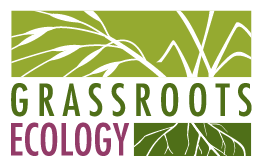Re-Oaking Silicon Valley: From Research to Action
It can be hard to imagine a past when Silicon Valley was covered in oaks, but can you imagine a future where this is the case?
We can. And for the past six years, Grassroots Ecology has set to work re-oaking several Silicon Valley preserves. We’re excited to share with you what we’ve done and what we’ve learned along the way.
But first, let me explain what exactly I mean by “re-oaking.” Though it may seem self-explanatory, it’s actually about more than just planting oak trees! It’s a term coined by our partners at the San Francisco Estuary Institute (SFEI) to describe an approach to integrating oaks—and other native trees and plants that grow in California’s oak ecosystems—into our developed landscapes in order to provide valuable functions for wildlife and people, from shade to biodiversity to carbon storage.
With SFEI’s visionary Re-Oaking Silicon Valley publication as our guiding framework, six years ago Grassroots Ecology set out to put their ideas into action. In partnership with three cities and with grant funding from Valley Water, we launched our Re-Oaking Silicon Valley Project in 2020.
In the years since, we have installed hundreds of oaks, willows, buckeyes, and other native trees at four city preserves: Foothills Nature Preserve and Pearson-Arastradero Preserve in Palo Alto, Byrne Preserve in Los Altos Hills, and McClellan Ranch Preserve in Cupertino.
Volunteers—more than 500 youth and adults from all over Silicon Valley—played an instrumental role at every step, including:
Gathering thousands of acorns and buckeye nuts and planting them into hundreds of earthen “basins” to facilitate germination
Harvesting and planting live willow stakes along creek banks to restore willow trees to riparian corridors (pictured, right)
Installing and maintaining over 300 trees (both oaks and their “friends”) grown at our Native Plant Nursery including valley oak, coast live oak, big leaf maple, California buckeye, western sycamore, holly leaf cherry, mountain mahogany, toyon, and blue elderberry
Monitoring trees planted to track maintenance needs and determine survivability
What did we learn?
Based on our monitoring surveys, overall survivability of planted trees was about 50% — which are good results for restoration planting! But rates varied quite a bit by species, findings that will help guide future re-oaking efforts.
For example, valley oak (Quercus lobata) had the highest survivability of any species planted, with 75% of valley oaks surviving as of spring 2023! Toyon (Heteromeles arbutifolia), California buckeye (Aesculus californica), and mountain mahogany (Cercocarpus betuloides) also performed well, with survivability of 50% or higher. Big leaf maple (Acer macrophyllum) is another noteworthy species, with 40% survivability. Western sycamore (Platanus racemosa) performed the poorest, with only 27% survivability.
In addition to monitoring if plants were simply alive or dead, we gave each tree a vigor score to determine health. Trees that were thriving and showing vigorous growth received a 3, trees that were alive and well got a score of 2, trees that were alive but not doing well got a score of 1, and dead trees received a score of 0. A score of 2 or 3 was documented as “alive” and a score of 0 or 1 was considered “not surviving.”
The chart below shows the scores by species. As you can see from the chart, when it comes to vigor, valley oak was once again the champ, and big leaf maple continued to be noteworthy with all surviving trees receiving the highest health score.
And though we can’t monitor germination and survival of each acorn, buckeye nut, and willow stake planted, we see evidence of these trees taking root at our restoration sites!
Another valuable finding is that re-oaking proved to be an effective call to action for our community to get involved in restoration. Our interns, AmeriCorps members, Youth Stewards, and volunteers were energized by the call to restore oak ecosystems, with more than 500 people of diverse ages and backgrounds showing up over the course of 60 workdays.
Though this pilot project is complete, the work of re-oaking Silicon Valley has only just begun. And based on the lessons learned and people and partnerships galvanized through this project, we are hopeful that creating a more verdant, oak-filled future for Silicon Valley won’t be such a tough nut to crack!
By Kristen Williams, Habitat Restoration Director







